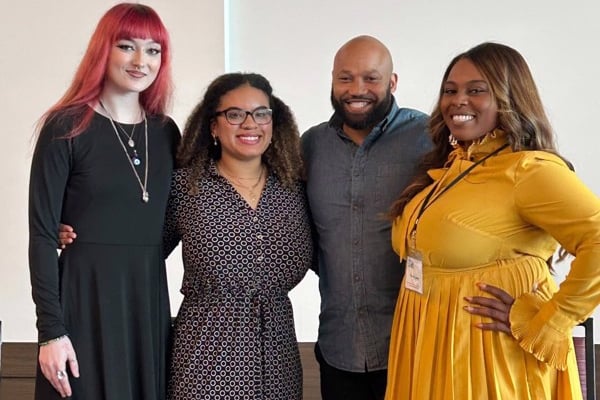You have /5 articles left.
Sign up for a free account or log in.

As part of the former foster youth support program, Alamo Colleges District hires student interns to provide programming and support to their peers. PATH interns Mercedes Ireland and Elizabeth Porak pose with Alamo Colleges staff at the 2023 Education Reach Conference.
Alamo Colleges District
College programs targeted toward students who have experience in foster care have proven results in promoting student success, providing essential nonacademic support for underresourced learners. One program, a partnership between three public San Antonio institutions and a county court, helps bridge gaps in completion for former foster youth by providing services before college enrollment, into community college and through upward transfer to a four-year institution.
The Bexar County Fostering Educational Success Pilot Project unites community partners and resources to help former foster youth from middle school through their graduation from a college degree program.
What’s the need: The pilot launched in 2019 as a partnership between Alamo Colleges District (ACD), Bexar County Children’s Court and Child Advocates San Antonio, the University of Texas at San Antonio, and Texas A&M University, San Antonio.
In 2021, there were 28,042 children in Texas’s foster care system, according to data from the Adoption and Foster Care Analysis and Reporting System. In 2022, Bexar County had an average of 1,648 children in paid foster care each month, according to the Texas Department of Family and Protective Services (DFPS).
The program was designed to streamline services available to former foster youth in entering higher education.
The state of Texas offers tuition exemptions for former foster youth, including those adopted from DFPS, at all state-supported colleges and universities. There is no age limit on the waiver, but students must meet their institution’s GPA policy for financial aid eligibility and not complete “excessive credit hours.”
The goal is to help middle and high schoolers who are still in the foster care system understand that college is attainable to them, explains Nathalie Riojas, grant project director for the foster youth program at Alamo Colleges District.
The program: Students start in the Bexar County Fostering Educational Success (BCFES) Cultivating Learning in Middle School and Beyond program prior to high school. Its college-readiness curriculum is offered online and provides college exploration opportunities as well as teaching students how to use services such as dual enrollment and TRIO.
Then, as students are enrolling in college, partner institutions provide an on-ramp through on-campus programs. Alamo Colleges hosts the PATH program, short for Partnering, Assisting and Transforming for Higher Education, which serves around 38 percent of the college’s 529 identified foster youth. PATH is optional but does require students to self-identify.
The Alamo Colleges District annually enrolls the largest number of foster youth using tuition waivers in the state, between 16 to 18 percent of all foster youth in Texas higher ed.
Basic needs support: After a student opts in to PATH, staffers complete an intake assessment and service needs assessment to understand the individual’s situation.
Housing and other basic needs support are among the biggest obstacles for former foster youth, as some age out of the system and lose support from the state.
“Our students, they aged out of foster care, and some of them will show up at our college campuses and just have a trash bag and not have a lot of resources,” says Gilberto Becerra, associate vice chancellor for advocacy, retention and completion.
Students receive up to $500 in emergency financial aid throughout the academic year from ACD, with additional funds provided by a private donor.
ACD provides learners with some starter supplies, including bedspreads and drying racks, to get them settled and comfortable. The district also partners with outside groups, including Opportunity Home San Antonio, BCFES and UTSA, to house students.
In addition, the district is connected with other institutions and community resources to fill in gaps. “We just really want to make sure we’re building out a very robust program for our students and that they are aware of their benefits and the program,” Riojas says.
Guiding students: Providing students with a support system is critical to their success, Riojas says. “They know that they get the waiver, but they don’t know where it goes, and it can be overwhelming.”
Each of the ACD campuses has a dedicated advocate to support former foster youth, walking them through the enrollment process and providing a warm hand-off to the appropriate department if needed. The advocates are housed in the advocacy centers on campus, working alongside basic needs staff, case managers and mental health counselors, says Leticia Duncan-Brosnan, director of the district student advocacy network.
Advocates complete several training programs to ensure they’re equipped to help foster students, including earning a trauma-informed care certificate as well as participating in suicide prevention and adverse child experience training and foster coach certification programs.
Creating a network: PATH staff emphasize the importance of building a peer network with other former foster youth and facilitate spaces for learners to do so.
“We’re always trying to make sure our students know that they’re not alone in this, that this is a shared journey between them and their peers,” Riojas says.
Before the start of the term, all PATH students participate in an early start experience, introducing them to financial aid staff, academic advisers and a community resource partner.
Throughout the academic year, staffers host fun events, such as an annual Friendsgiving meal, bowling at nearby St. Phillip’s College or a s’more-making event. PATH hires student interns who lead programming, as well, most recently hosting a financial literacy workshop.

Debbie Jennings, UT Health Science Center partner; Juan Reyna, UTSA Fostering Future’s outreach and events manager; and PATH student Devon McKinney enjoy s’mores on the balcony at Alamo Colleges at the third annual PATH Friendsgiving event.
Alamo Colleges District
The impact: PATH participants from the fall 2022 to 2023 cohort had a 67.2 percent persistence rate, compared to their first-time college peers (65.7 percent). Last spring, the program graduated 52 students who earned 72 degrees and certificates, bringing the total number of PATH participant credentials up to 336 since fall 2020.
A majority of PATH graduates transfer to local institutions, including UTSA and Texas A&M San Antonio.
“That partnership with UTSA and A&M San Antonio … provides a natural path,” Becerra says. “Once they get out of our [program], they go into theirs.”
In the future, ACD leaders are considering ways to keep funding sustainable and able to cover all student costs, as well as how to attract additional students. The district is also reviewing institutional policies to smooth out the student experience from enrollment to graduation.
We bet your colleague would like this article, too. Send them this link to subscribe to our weekday newsletter on Student Success.
This article has been updated to correct the name of Opportunity Home San Antonio, formerly the San Antonio Housing Authority.




